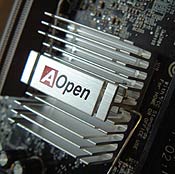3DMark2001 SE is the latest installment in
the 3DMark series by MadOnion. By combining DirectX8 support with completely new
graphics, it continues to provide good overall system benchmarks. 3DMark2001 SE
has been created in cooperation with the major 3D accelerator and processor
manufacturers to provide a reliable set of diagnostic tools. The suite
demonstrates 3D gaming performance by using real-world gaming technology to test
a system's true performance abilities. Tests include: DirectX8 Vertex Shaders,
Pixel Shaders and Point Sprites, DOT3 and Environment Mapped Bump Mapping,
support for Full Scene Anti-aliasing and Texture Compression and two game tests
using Ipion real-time physics. Higher 3DMark scores denote better
performance.
| 3DMark 2001 SE Benchmark Results |
|
Motherboards |
3DMarks |
Ranking |
| 1. |
AX45-V - 100 MHz FSB |
7156 |

|
| 2. |
AX45-V - 108 MHz FSB |
7570 |
 |
| 3. |
P4PA - 100 MHz FSB |
7791 |
 |
| 4. |
4D845A - 100 MHz FSB |
7723 |
 |
We're not
really sure what's going on here. 3DMark2001 was run several times
yet the scores for the AX45-V stayed the same. At stock speeds, the
AX45-V is about 600 points lower then then either the P4X266A or the i845-D and
even when the system is overclocked, it can't seem to reach the other motherboard's numbers
- which is very odd, but may be do to the unique BIOS settings.
Quake III Arena is a First Person Shooter (FPS)
that revolutionized gaming as we know it. Using multiple light sources and
having graphics textures that can fill videocards, even after 3 years it's still
able to bring a cutting edge system to its knees.
| Quake III Arena Fastest demo001 |
|
Motherboard |
FPS |
Ranking |
| 1. |
AX45-V - 100 MHz |
252.1 |

|
| 2. |
AX45-V - 105 MHz |
271.6 |
 |
| 3. |
P4PA - 100 MHz |
282.8 |
 |
| 4. |
4D845A - 100 MHz |
261.1 |
 |
| Quake III Arena Fastest nv15demo |
|
Motherboard |
FPS |
Ranking |
| 1. |
AX45-V -
100 MHz |
69.3 |

|
| 2. |
AX45-V - 108 MHz |
73.8 |
 |
| 3. |
P4PA - 100 MHz |
76.3 |
 |
| 4. |
4D845A - 100 MHz |
73 |
 |
With the
fastest settings, the AX45-V is again bringing it up in the rear again. Even when it's overclocked,
the system just can't seem to keep up with the VIA's P4PA motherboard. This
is quite odd since the Epox 4SDA+ which was also a SiS 645 board was
much faster.
| Quake III Arena MAX 1024x768 demo001
|
|
Motherboard |
FPS |
Ranking |
| 1. |
AX45-V - 100 MHz |
182.6 |

|
| 2. |
AX45-V - 108 MHz |
188.8 |
 |
| 3. |
P4PA - 100 MHz |
187.3 |
 |
| 4. |
4D845A - 100 MHz |
186.3 |
 |
| Quake III Arena MAX 1024x768 nv15demo
|
|
Motherboard |
FPS |
Ranking |
| 1. |
AX45-V -
100 MHz |
48 |

|
| 2. |
AX45-V - 107 MHz |
52.1 |
 |
| 3. |
P4PA - 100 MHz |
52.2 |
 |
| 4. |
4D845A - 100 MHz |
49.6 |
 |
With the
resolution set to 1024x768 and alll the eye candy on, the AX45-V pushes some decent numbers, but it's
still lower then the competition. Even when it's overclocked the AX45-V can't really
blast away it's competitors in the nv15demo, and we must say this is not very AOpen
like.
Conclusion:
 It's nice to see more and more
motherboard manufacturers like AOpen embrace new technology like the SiS 645 chipset. Like
other AOpen products stability was never an issue, and we didn't have a single problem
with the board during testing and overclocking.
It's nice to see more and more
motherboard manufacturers like AOpen embrace new technology like the SiS 645 chipset. Like
other AOpen products stability was never an issue, and we didn't have a single problem
with the board during testing and overclocking.
AOpen told
us right from the beginning that this board was not built to cater towards
the enthusiast market and we can understand that. With so much competition for such
a small market, it just doesn't make sense for them and that's why there aren't
many overclocking functions.
We were very pleased with the overall quality
of the motherboard and you can definitely tell where the care and attention to detail
was used in producing this motherboard. A prime example is the backplate under the
CPU socket. It is a great feature which keeps the board from warping after the CPU
heatsink is installed.
With three DIMM slots, a 4x AGP slot and 6 PCI's the
board is pretty future ready and the addition of an onboard Ethernet port is
just icing on the cake. With broadband internet connections or a home
network as prevalent as they are today, just about every computer needs to have
a NIC card, and by including it on the motherboard it makes things easier for
the end user. Onboard audio is using the VIA AC'97 codec which isn't as
great as hardware based cards, but still brings decent sound to the user. With everything we have seen here AOpen
have a good thing going, 3D performance wasn't at the top of the
pack, but hopefully this is something that can be tweaked and tuned in
future driver updates - making this an even better board.
